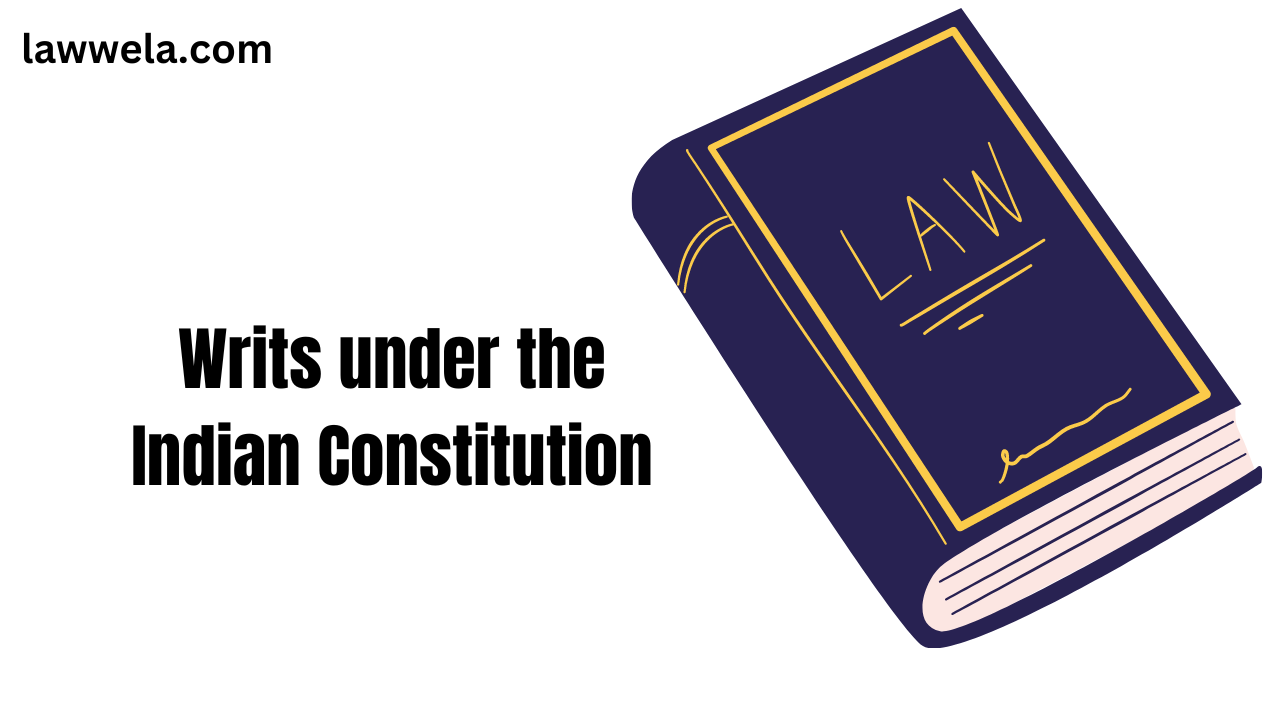A writ is an official written order issued by a judicial authority. The courts like supreme and high courts have the power to issue a writ petition. The writs are borrowed by England in India. The word Writs means command in writing issued by the court. Writs are issued by the Supreme Court under Article 32 of the Indian Constitution and Article 226 high court issue the writs.
Meaning of Writs
The writ is a written order by the Supreme Court and High Court issued to another person or authority by which they have to act in a certain way. Which is an important part of the Indian constitution It is provided to protect the fundamental rights of the citizens.
Writs under constitution
In the Indian constitution under Article 32, the Supreme Court has the power to issue a writ when any fundamental right of a citizen is violated. Every citizen has a right to approach the Supreme Court for enforcement of his rights and the court issues the suitable writ.
Under Article 226 the citizen can approach the high court for other matters also where the rights are not violated.
Smt. Imtiaz Bano vs. Masood Ahmad Jafri and Ors.
A mother filed a habeas corpus writ petition under Article 226 for the custody of her 2 children. The high court allowed the writ petition in her favor.
Illustration – A is a citizen of India whose fundamental rights are infringed. Here A has an opportunity to go to both Supreme and High Court. But if his right is not fundamental, he has to go to the high court to enforce it under Article 226.
So there is a right given to the citizen of India to choose either of them but if his suit is dismissed in any court, he cannot file the same suit in the other court. In India, there is a principle called res judicata which means that a second time case cannot be filed for the same cause of action. But if a case is not in favour of his in High Court then he has the right to approach the Supreme Court of India.

Different types of writs
Under articles 32 and 226 in the Indian constitution, there are 5 writs. These are-:
-
Habeas corpus
It is derived from the Latin word habeas corpus which means “to have a body”. It is used to release an individual who has been arrested or imprisoned unlawfully. It is the most effective remedy. Due to this writ court can command the person or authority to bring that person who has been detained or restrained by another person to be present in the court. The court commands the detaining person to give the valid ground on which he has been detained the person and if he fails to provide the valid ground then the person who has been restrained will be released by the court.
If the person who is restrained cannot approach the court then anybody on his behalf can apply for the writ in the court.
For example- A is in the custody of B who is a police officer. A has the right to approach the High Court regarding this matter. Then the High Court summoned the police officer with A and asked the grounds on which behalf he has been detaining A. If he fails to provide a valid reason the court will release A immediately.
Gopalan vs. Government of India
In this case, the Supreme Court stated that the earliest date regarding which the legality of detention may be examined is the date on which the application for the same is made to the court.
Basic rules of Habeas Corpus
- The person who has been detained should be in the custody of another.
- The writ can be filled by the detained person or by his family members but in public matters a stranger can also file a writ application to the court.
- The application of writ is filled only one judge in the court it cannot be made the applications to 2 different judges in the same court.
- To fill this writ it is not necessary to write in a prescribed manner it can be formal or informal.
Sunil Batra vs. Delhi administration
In this case, the Supreme Court accepted the writ application made by a stranger, Because of the inhuman treatment of the prisoners in the jail, and the writ of habeas corpus was issued. It is issued not only for unlawful arrest but also for the protection of the prisoners who have been treated as inhuman or maltreated by the authorities.
-
Mandamus
The meaning of Mandamus is “we command”. It is issued by the superior court to the inferior court to do the duties which they cannot be refused to perform. It also can be issued by the court against the public officers, public tribunal, board, corporation, or any other government authorities. it cannot be issued against any private person or government of the State. The Writ of Mandamus is issued to any kind of authority in respect of any type of purpose like administrative, or legislative; it is used to enforce the public duties by public authorities. Mandamus is issued when a legal authority fails to do its legal duty to implement the order of a tribunal, it is issued to directing the authority to do so.
Bhopal Sugar Industries Ltd vs. Income Tax Officer, Bhopal
In this case, the Income tax tribunal gave directions to the Income Tax officer to do its final order but they still refused to do the direction given by the tribunal. So the Supreme Court held that the Income Tax officer had to do the direction given by the tribunal here the writ mandamus is issued by the court to direct the officer to do the directions given by the Income tax tribunal.
Ratlam Municipal vs. Vardhi Chand
In this case, the Court held that Ratlam Municipal is a statutory body whose duty toward the public is to remove the night soil, public nuisance, etc. So the court issued the writ mandamus and enforced the duties of the municipality.
-
Certiorari
The certiorari is very different from other writs. It means “to be notified” or “to be correct”. This type of writ is only used in judicial or quasi-judicial proceedings. It is used by a superior court to an inferior court. It is used when the Superior Court needs to change the court procedure of the inferior Court. If the superior court finds any error or violation in the fundamental rights it can quash the order of the inferior court.
Important points for certiorari
For the approval of this Writ, there are some conditions which are :
- The individual or person should have legal authority.
- Those authorities should be related to those questions which are affecting the rights of the people.
- When carrying out its duties, such an organization or individual must act judicially.
- Such a person or organization has behaved outside the bounds of their authority or jurisdiction.
-
Quo Warranto
The meaning of Quo Warranto is “What is your authority”. It is used to issue against the owner of a public office to confirm the court under what authority he holds the office. This writ is used to restrain a person from going to public offices where they are not permitted.
Conditions for approving Quo Warranto
For the approval of this writ, there are some conditions which should be fulfilled:
- The office assumed by the private person should be a public office.
- The office must be created by the public authorities or by the constitution and the person should not be qualified to hold the office.
- The office’s term must be permanent and cannot be ended at the will of any person or authority.
- The person in search of the writ is the one who occupies and uses the offices against whom the writ is issued.
- It is also used in those cases where a person is holding the office earlier but after his disqualification, he is still in the possession of that office.
Jamalpur Arya Samaj Sabha vs. Dr. D Rama
Under this case, there is a working committee of Bihar Raj Arya which are private office. So the petitioner filed an application to the High Court of Patna for the writ of Quo Warranto but the court refused to issue the writ because it is not a public office.
Prohibition
The meaning of prohibition is almost the same as the certiorari but there is a difference between them. Under the writ of prohibition, the superior court has the power to stop the court procedure in the inferior court before the case is decided. But in certiorari, it can change the decision of the case after the final order.
It is issued when the inferior court or tribunal acts outside its jurisdiction. It is illegal to decide a case by an inferior court outside its jurisdiction or violation of rules.
Writ of Prohibition issued when:
- It proceeds outside the jurisdiction or more than its jurisdiction.
- It acts when there is a violation of the rule of Natural rights or fundamental rights.
Conclusion
In the Indian Constitution, there are 5 types of writs which is used for the citizens of India. It is enforced when the rights of the people are violated or it binds the authorities to do properly their duties towards the citizens of India.

